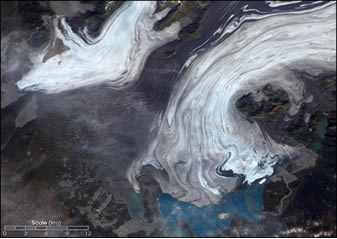
 |
Bering Glacier Melts FasterJune 4, 2007Courtesy of Far North Science New measurements have confirmed that North America's largest glacier has been melting away about twice as fast as scientists previously thought. 
Bering Glacier on 9/29/2002 Credit: NASA Earth observatory The immense Bering Glacier - which covers more than 2,000 square miles on Alaska's "lost coast" between Prince William Sound and Yakutat - has been spewing more than seven cubic miles of water into the Gulf of Alaska each season, according to calculations by Robert Shuchman, co-director of the Michigan Tech Research Institute (MTRI). That's about 1.1 trillion gallons of water, more than twice the volume found in the Colorado River system, Shuchman said. It's about 20 times the annual flow of the Yukon River, based on an annual estimate of 225,000 cubic feet per second. A news release from Michigan Tech Research Insitute explains further. "This could potentially change the circulation of coastal currents in the Gulf of Alaska," Shuchman said. Those currents are key factors in tempering climate, redistributing nutrients in the water and providing adequate food for the salmon and marine animals, he explained. As glaciers melt, sea levels rise, and "sea level rise affects everyone," Shuchman added. "If it continues to rise at this rate, parts of the state of Florida could be under water at the turn of the next century." The MTRI team, working with U.S. Geological Survey (USGS) and U.S. Bureau of Land Management (BLM) scientists, designed the sensor that enabled BLM to accurately measure and analyze the melting of this Alaskan glacier. Shuchman and his team, along with BLM and USGS, have been studying the glacier for the past decade with an interdisciplinary team of geologists, oceanographers, botanists, and marine mammal, bird and fish experts. "Our glacier observations are 10 times better and 10 times less costly than data collected the old way," Shuchman said. Before MTRI developed its autonomous sensor to collect data as it occurs, scientists had to make dangerous and difficult treks to remote regions to measure glacial melting. Famous for its sudden surges that can overtake and flatten new growth, the Bering Glacier extends about 120 miles into Alaska's coastal mountains, and once covered more than 2,000 square miles (about 80 percent the size of the state of Delaware.) But the glacier has been retreating up to 10 miles per year. |
|